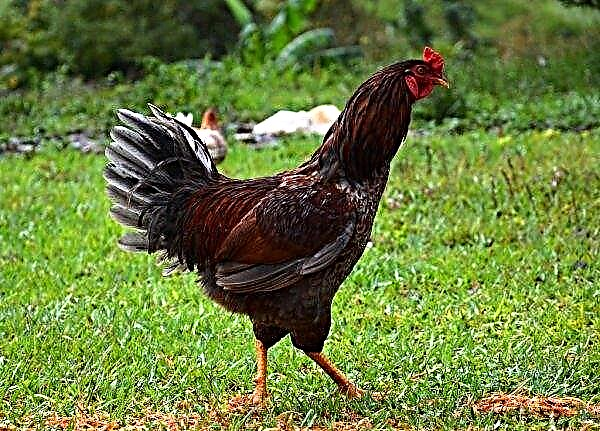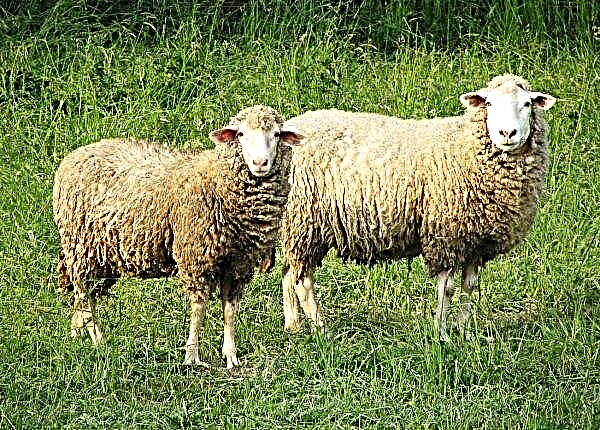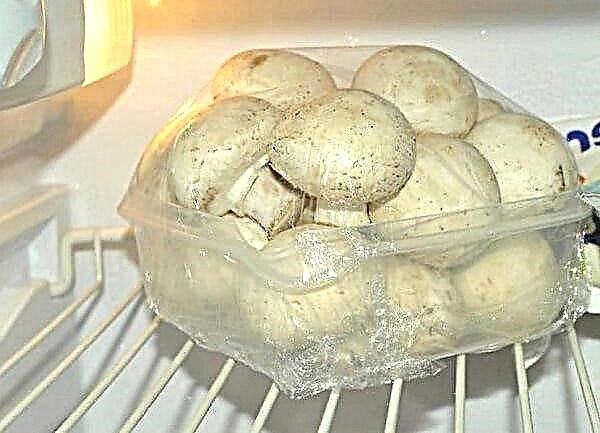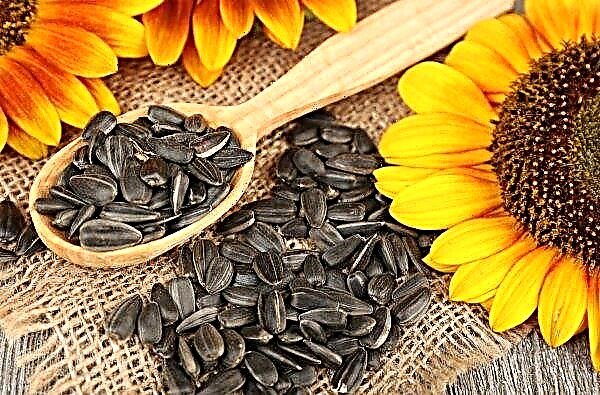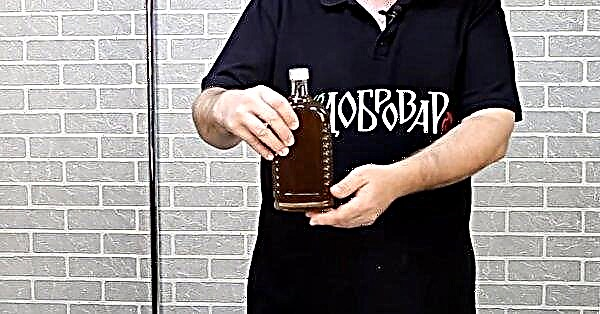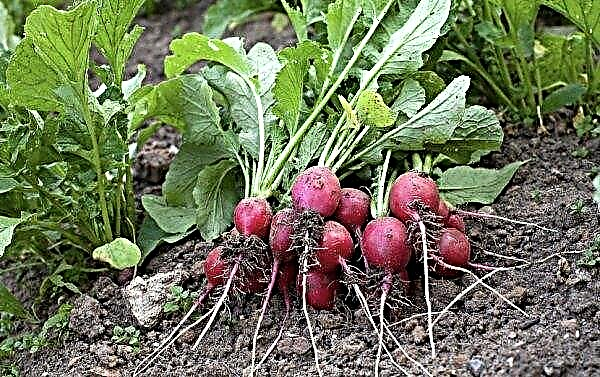Propolis (bee glue, bond) is used today in the pharmacological, perfumery and food industries. And he gained wide popularity in cosmetology, because it makes the skin of the face and body beautiful. The article will tell how you can use this beekeeping product for a healthy look of different types of dermis, how to make masks with this ingredient, and also what contraindications there are to the use of this bee product.
Composition and properties of propolis
Propolis is a dark-colored sticky substance collected by bees from young buds of different trees (renal glue), and then succumb to fermentation. They use it as an insulating material and as a means of sealing unnecessary holes in hives.
Did you know? Propolis is called a natural antibiotic produced by bees. Using this product inside the hive, these hard-working insects disinfect the air inside their home, after which it remains sterile for a long time.
Subsequently, beekeepers scraped this substance from special frames with honeycombs, collecting from one hive up to about 155 g of substance.

- The product is endowed with the following properties:
- has a bitter-spicy taste and gummy consistency;
- a freshly picked product is usually a pale brownish or dark green hue (the color differs from the type of trees on which the bees worked);
- subsequently, the product dries up, its color changes to brownish, the texture becomes denser, but it remains fragile at the same time;
- Uza retains all its useful qualities during heat treatment, therefore it is permissible to heat it before use;
- more than 200 other different compounds are present in the bee product (vegetable resins, terpenic acids, volatile and tannins, balsams, essential oils, essential amino acids, flavonoids, nicotinic and pantothenic acids, vitamins A, E, group B, zinc, manganese, potassium, sodium , magnesium, sulfur, phosphorus, copper, selenium, fluorine, etc.), and also contains wax;
- has a bactericidal effect, suppressing and destroying the activity of many viruses and bacteria (among them tuberculous mycobacteria, influenza virus and hepatitis pathogen);
- Uza, killing harmful microflora, does not provoke dysbiosis;
- an adhesive substance can be used simultaneously with some antibiotic drugs, since it enhances their effect;
- bee glue is known for its anti-inflammatory and anti-toxic effects, and also boosts immune forces;
- serves as a biostimulant, has regenerative properties and acts as an antioxidant;
- with its help, the body removes dead parasites and their metabolic products;
- serves as an anesthetic for exacerbation of gastritis, otitis media, as well as for frostbite, wounds, burns (including the eye), diseases of the oral cavity;
- used as an adjuvant for bone splicing in injuries and fractures;
- cosmetologists use propolis for rashes and acne, since it is able to heal small wounds on the dermis and relieve inflammation;
- softens the dermis, making it velvety and elastic;
- propolis is used in the complex treatment of stroke and heart attack (it helps to reduce scarring on the heart muscle and accelerate tissue regeneration).
Important! All beekeeping products are strong allergens. For this reason, in no case should you use propolis for the skin of the face without preliminary tests for the susceptibility of the dermis.
Features of the use of propolis in cosmetology
The use of a bee product for cosmetic purposes has its own characteristics, since in its natural form bee glue is inconvenient to use because of its dense structure:
- in the formulation of various skin care products, bee glue is used only when extracted (alcohol tincture or water tincture - the form of the drug depending on the type of dermis);
- due to its antiseptic, anesthetic, regenerating qualities, it is an ingredient in products for hair removal, in deodorizing preparations, creams and masks, tonics for make-up remover;
- from a natural substance, funds are made for the healing and strength of hair follicles (nutrients can accelerate hair growth, remove dandruff, make hair shiny and lush);
- Due to its preserving properties, a bee product is often used as a preservative for cosmetic preparations.

Product Efficiency
The use of the described natural beekeeping product in medicine and cosmetology will be effective only when its use is agreed with the attending physician or cosmetologist, as well as in the absence of contraindications and the correct implementation of all recommendations. It is important to understand that the use of propolis can be successful only in the initial stages of diseases or cosmetic problems. Although with its help it is possible to get rid of unpleasant symptoms, it is not worth counting on the use of drugs with propolis as the main method of treatment.
Did you know? Altai shamans knew about the ability of propolis to repeatedly increase the benefits of elements mixed with it, and believed that if they were smeared with bee glue magic charms and then If you place them in the nests of bees, then this will enhance the healing effect they produce.
How to use propolis
It is very important to use bee glue in home cosmetology.
It is important to follow some recommendations:
- Before using preparations with propolis, it is necessary to check the skin for sensitivity (wipe the product on the wrists on the inside and leave the reaction to manifest for several minutes).
- You need to find the right skin type recipe to fix cosmetic problems.
- The components for homemade cosmetic masks with bee products are mixed exclusively in wooden, glass and ceramic bowls.
- Before applying the mask, to completely clean the dermis and a good perception of cosmetic procedures, it is necessary to arrange a steam bath for the dermis, and then carefully treat it with a scrub.
- The funds are applied to the face for no more than 20 minutes, gently applying them with your fingertips or a spatula.
- Cosmetic substances with bee glue are used no more than twice every 5-7 days (for treatment) and once a week - as a preventive.
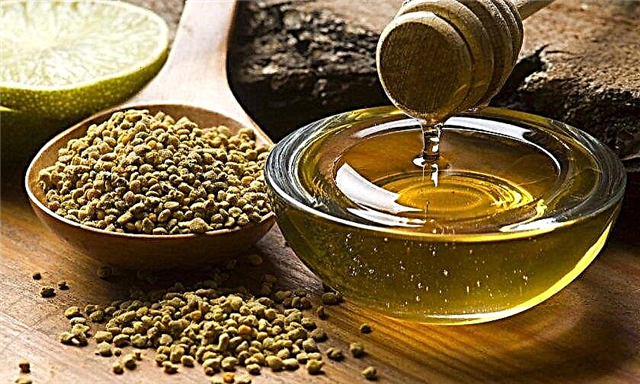
Consider how you can use a bee remedy, adding to the mask to moisturize the face, as well as from its age-related changes and wrinkles.
For dry skin
This type of skin is prone to rapid dehydration, which leads to its early aging and the appearance of a network of wrinkles. To avoid this, you can prepare the following masks.
For peeling skin
Ingredients:
- bee glue tincture: 2 tbsp. l .;
- egg yolk: 1 pc.;
- natural honey: 1 tsp
Walkthrough Cooking:
- Put natural honey in a water bath.
- Strain the tin ties with honey and add the egg yolk.
- Apply the mask to the face and leave for 15-20 minutes.
Moisturizing
Ingredients:
- white clay: 1 tbsp. l .;
- St. John's wort essential oil: 1 tbsp. l .;
- bee glue tincture: 1/2 tsp.
- yogurt (homemade): 2 tbsp. l
Walkthrough Cooking:
- Mix white clay with St. John's wort essential oil.
- Pour tincture of bee glue and homemade yogurt to the clay-oil mixture.
- Spread the mixture over your face and let it dry (15 minutes), then wash.
Such toning and nutrition will allow the dermis, which has suffered from drying and peeling, to return to normal.

For combination skin
This type of dermis has areas with oily and normal or oily and dry skin, so it needs nutrition and refreshment.
Nourishing mask
The right ingredients:
- propolis (tincture): 1 tsp;
- fruit puree: 2 tbsp. l
Walkthrough Cooking:
- Using a blender, prepare fresh fruit puree (pear-apple-orange).
- Mix fruit puree with propolis tincture.
- Apply the mass on the face for 15-20 minutes, and then rinse with cool water.
Important! Be sure to adhere to the exact formulation when preparing face masks with propolis. Also, do not independently supplement the preparation in preparation with components not specified in the recipe, otherwise the product may produce an unpredictable effect or cause an allergic reaction.
Anti-aging
Ingredients:
- natural honey: 1 tbsp. l .;
- unrefined olive oil: 1 tsp
- Warm natural honey in a water bath.
- Add olive oil and propolis tincture to the preheated honey.
- Put on the face the prepared product and leave for 15 minutes.
- Wash off with warm water.

For oily skin
Due to improper care or unbalanced nutrition, oily skin can become covered with rashes, gloss out from greasy and even peel off. The following masks will help remove these problems.
From rashes
Ingredients:
- natural honey: 1 tbsp. l .;
- propolis tincture: 1/2 tsp;
- mud powder: 1 tbsp. l .;
- mineral water: 1 tbsp. l .;
- essential oils (rosemary + tea tree): 1 drop.
Walkthrough Cooking:
- Mix natural liquid honey with propolis tincture.
- Dilute therapeutic mud with mineral water.
- Add essential oils to the mud pulp.
- Beat both mixtures separately with a blender, and then mix with each other.
- To smear a face skin and to leave for 20 min., And then to wash off.
Oily sheen
Ingredients:
- propolis tincture: 1.5 tsp;
- cotton pads: 1-2 pcs.
- Moisten a cotton pad in propolis tincture and wipe the face.
- Allow the face to dry and apply a matting cream.
- This procedure is applied every day (10 days).

Contraindications
Despite the fact that a bee product has undoubted health benefits in general, there are people who have intolerance to bee products in the form of allergies. If a person suffers from allergic reactions to bee stings or to honey, then there is a high probability of intolerance and propolis. It can manifest as rashes, itching, and redness of the skin.
However, it must be borne in mind that propolis and honey are different substances, therefore, a person can transfer one product, and he may have a strong allergy to another. Therefore, before using bee glue in the preparation of preparations for the face, you need to make sure that it does not cause allergies.
If you suffer from dermatological problems, try to make cosmetic masks with your own hands from bee glue according to the above recipes. The described procedures will have a quick effect and lasting therapeutic effect, which will help get rid of skin problems and help to have an attractive look at any age.


